The trip from Potosi to Uyuni was rather long – it took us 6 hours to cover some 200 km because the coach drove over a dirt road covered by gravel. The transportation was a slightly modernized version of a chicken bus, but it was ok. Admittedly, at first I had to get used to exhaust gases that slightly leaked into the passenger cabin, but in the end the main problem was dust that entered probably through the floor since the windows were shut tight. The window situation also proved to be problematic when it got quite hot in the coach during the day and no window could be opened.
Still, not everything was bad. I sat next to a very nice guy, Alfredo, and chatted with him occasionally. The rest of the time I spent watching the landscapes we went through. Potosi is at 4100 m above sea level and Uyuni is at 3668 m, so we went along the same altitude more or less, but everything seemed like a desert or rather a wasteland. There were no trees to speak of, bushes were but a rare phenomenon and the only regularly encountered vegetation were clumps of grass scattered across the barren soil that dominated the scenery. I did see on occasion, though, some cacti in valleys and on naturally protected slopes, and in one broader depression I saw a few trees similar to willows and poplars. However, what made the strongest impression on me were the colours that appeared incredible: ochre, gray-yellowish, rarely greenish, and at one point we entered a section where the rocks around us and the entire landscape were in reddish tones.
The road mostly led across the inclines of elevated ground, over passes and along plateaus, but in a couple of places it dropped into small canyons as well: first it would follow the edge, then it would go down, then along the bottom of the canyon, crossing it and then taking us up again to the other side. All in all, regardless of the transportation conditions I was very happy to have taken that road, because the views were marvellous.
When I finally reached Uyuni I thought “What a place!” It was founded in 1889 at a railway crossing and it is located at a very flat plateau at the official altitude of 3668 m. Uyuni is completely away from the rest of the country, but I went there with a specific intention to go on a three-day trip across the south-west Bolivia. These trips across the far-away places of the country are indeed the main reason why tourists venture here at all, so Uyuni is completely focused on meeting the needs of visitors it basically lives on. Thus, even at a very modest hotel in which I stayed I had a heater and managed later to warm up the room in which I slept. Still, the first thing I did after leaving my things at the hotel was to go to an agency and pay for a trip that was leaving the day after.
Then I walked around the place a little and went to an internet cafe. When I say walked around the place, I mean I covered a couple of hundred metres in one way and then the same in the other, and that was it. Then I headed for the central square. When I got there, I saw a crowd of people looking towards the centre where a military band played some tune. There were officers, soldiers, children, ordinary citizens and tourists, and they were all standing still. Not thinking too much, I continued to walk wanting to get closer and see in more detail what was going on. And then I suddenly spotted a soldier who started to go in my direction and I finally became aware that I was the only person moving. I momentarily stopped and the soldier went back to his place. I suppose that the music in question must have been the Bolivian anthem. I really didn’t have any intention of not showing respect for the country and the nation I came to love so much in the meantime. It was simply a moment of inattention and not thinking, as well as of ignorance. Even today, I have no clue about the tune of the national anthem of Bolivia.
On the other hand, this situation has inspired me to think a little about the whole thing – the state, the nation and the holidays. Let me clarify, the next day was the Day of Independence and this was the occasion for organizing the military music and the festivity in the main square of Uyuni. At about the same time, Peru was also marking its national holiday (National Day of Independence) and I could see in both countries how much they respected their national holidays, how much attention they pay to them, wearing badges with the national flag for weeks ahead, they loved to celebrate them and I actually found that to be very nice. Through some specific circumstances I have changed several countries without moving my home at all and I think that in the process my co-nationals as well as I have lost that feeling of being attached to some special dates. New Year’s Day has survived mostly because it is a universal party time. May Day (1 May) has turned from celebrating labour rights into a holiday of picnics with open fires in parks and forests. But after “losing” the Republic Day (of the SFR Yugoslavia), colloquially referred to by the first date of its celebration “29 November,” I don’t think we have ever managed to get this level of attachment to a holiday celebrating statehood or something linked to the entire nation living in the country (it is with clear purpose that I don’t want to talk of holidays that are more of religious and/or commercial nature). In Bolivia and Peru, people still rejoice in their national holidays and festivities, as well as different causes for celebration, and they seem to be very proud of them (for instance, the University carnival in La Paz).
After this protocol gaffe of mine, I bumped into a French couple with whom I had sailed across Titicaca to the Island of the Sun. They were smart and prepared well for the island, and unlike me spent the night there. This time we chatted for a while and when I told them I was from Serbia they were delighted since they adored Kusturica, the acclaimed Serbian film director!
At some point I went back to the hotel and as I was getting ready to go to bed, all of a sudden the air was filled with the loud music of a military brass band marching through the street in front of the hotel. As I’ve said, the next day was the Day of Independence and they had already started to celebrate it.
The following day it seemed a little warmer and I could even take my jackets (plural) off. First I went to buy a ticket to La Paz in order not to deal with that after my three-day trip. There is a train from Uyuni to La Paz and everybody said it was better and more comfortable than a coach, but I gave up on this combination since I would be waiting for the train until 1 or 2 after midnight. The coach was to leave at 9 pm, getting to Oruro at 3 after midnight and then I had another coach to La Paz around 4 am. Somehow I preferred this combination.
While out I called Ximenita in La Paz to let them know when to expect me and then I also rang my mom. Bolivia is a poor and relatively undeveloped country, but it has incredible and fantastic telephone lines. In such a remote place I made a call from a public phone booth to another remote place on the Earth and the line was established at once and I spoke with my mother as if we were in two adjoining rooms. I did learn at school all about the telephone and how it works and how it has all developed, with the introduction of satellites and the rest, and I do know and use all of that, but to this very day telephone remains a big mystery to me: how is it possible that we speak at such huge distances in the “real time” (I wonder what “unreal time” is) and yet there is not a single moment of delay in the transmission of signals.
So, having taken advantage of modern technologies, I went to the agency where the people from my group were slowly gathering. My group included a driver, three French, two Canadian (from Quebec), one Spanish (from Basque country) and me. The driver, who also played the role of a guide, was in charge of transportation which is during these tours usually organized in larger SUVs.
We soon left and first stopped at a village, Colchani, on the edge of a salt lake. This is where they gather to dig out salt, process it further, purify it in furnaces, add iodine and then sell. In addition to the production of kitchen salt, salt crystals are also used for making souvenirs for tourists. I didn’t like that a lot, but I found it impressive that salt was piled up in some places as if it were mounds of snow.
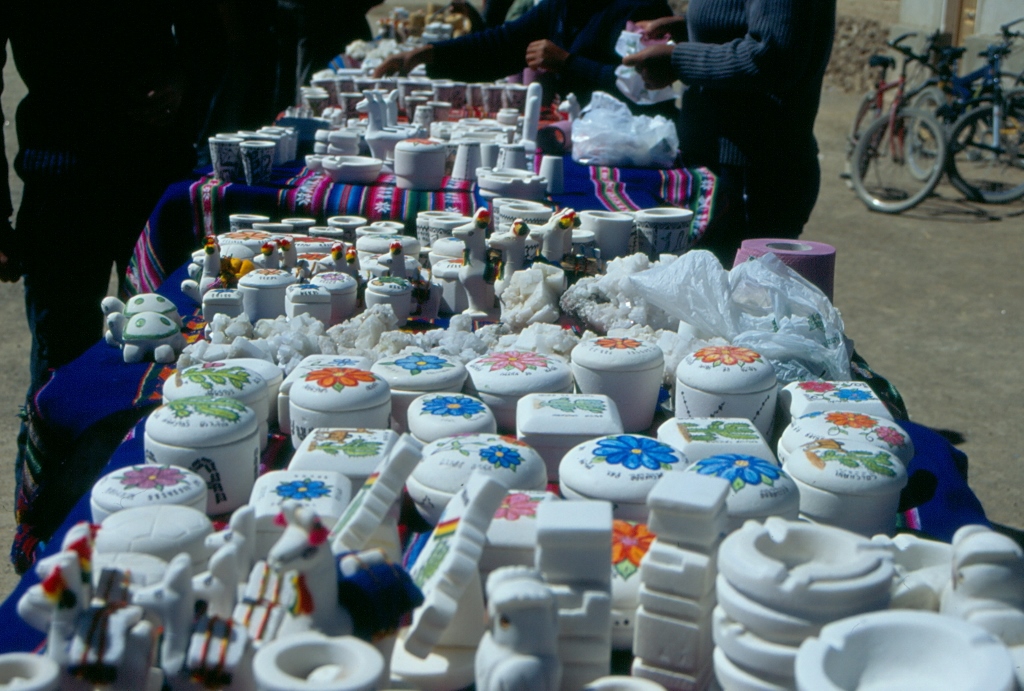 Souvenirs made of salt
Souvenirs made of salt
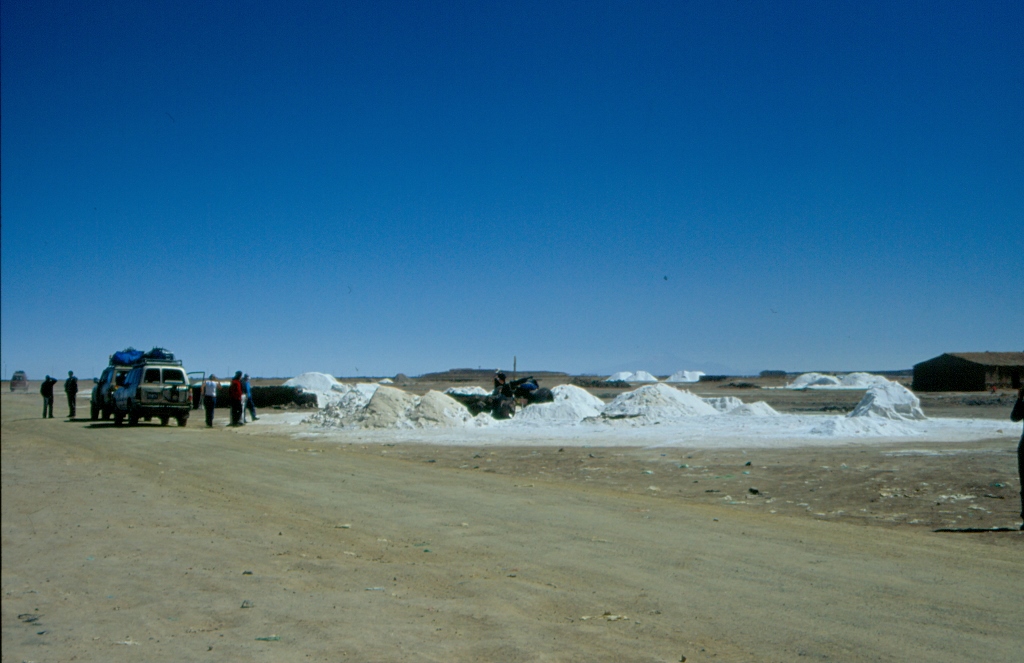 Salt waited to be processed, Colchani
Salt waited to be processed, Colchani
Afterwards we went well into the Salt Flat of Uyuni (Salar de Uyuni). This is by far the biggest salt lake, which is in fact a lake only a couple of months a year, during the rainy season. The depth of the water can be around 1 metre then. The rest of the time, when the water evaporates, a dry crust forms on the surface. This base is solid and hard enough for vehicles, SUVs and buses to drive on it. Salt is scratched off the surface and some 10 to 20 cm constitute the dried hard crust, while underneath there is a very saturated water solution. Salar de Uyuni covers the area of around 11,000 square kilometres (almost the same as the entire territory of Northern Ireland!). And it is all covered in salt. In some spots, salt deposits reach the depth of around 200 metres.
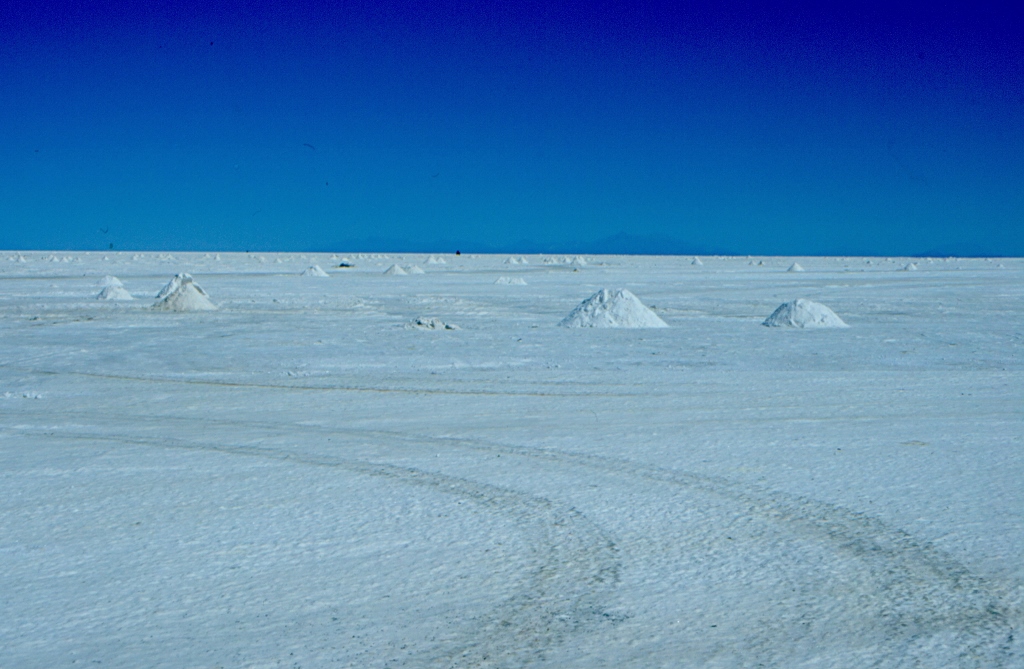 Salar de Uyuni – this is all salt!
Salar de Uyuni – this is all salt!
The scenery is completely magical – white, white, white and more white, all around us. In some places it is possible to see volcanoes and mountains in the distance and here and there on the salt flat itself there are also pieces of ground that constitute islands when there is water or just land elevations when the salt flat is dry. Salar de Uyuni is situated at around 3600 m above sea level, and every now and then one cannot see any other piece of landscape except the flat white surface and the immense blue sky above with some distant clouds above the horizon. I do feel the need to express my fascination again – this was a truly magical landscape.
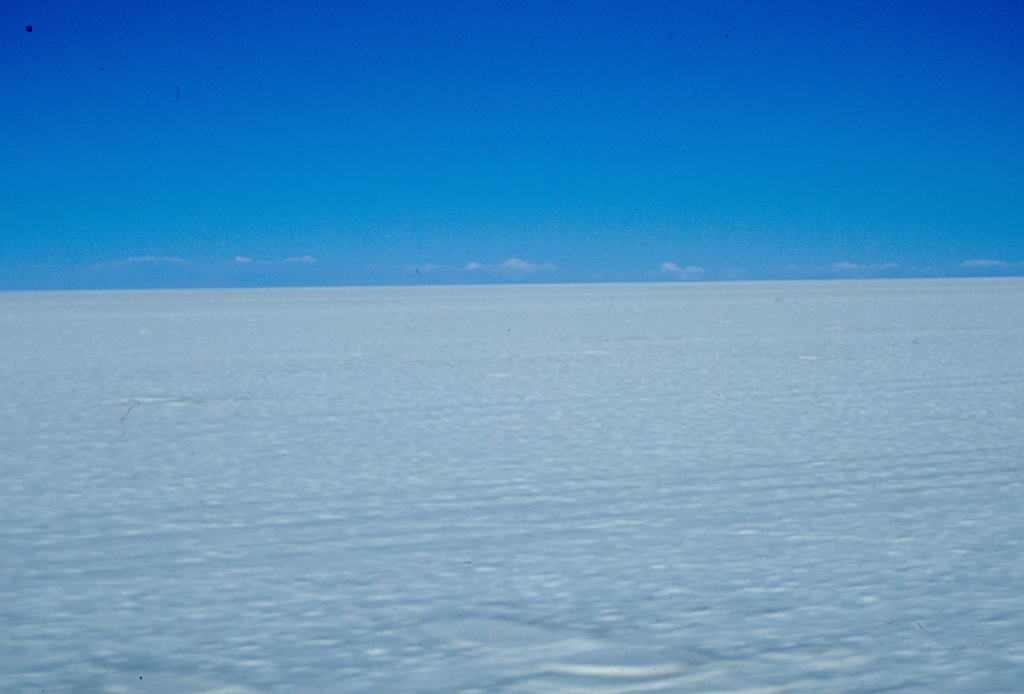 Salar de Uyuni
Salar de Uyuni
After a short drive, we had a break at a salt hotel. This is a building made of blocks of salt which took 12 years to construct. The interior is also made of salt – furniture and floor, with a furnace as the only metal element. The hotel even has a “pool” – a rectangular hole dug in front of the building in which, were it not cold, one could float and read newspapers.
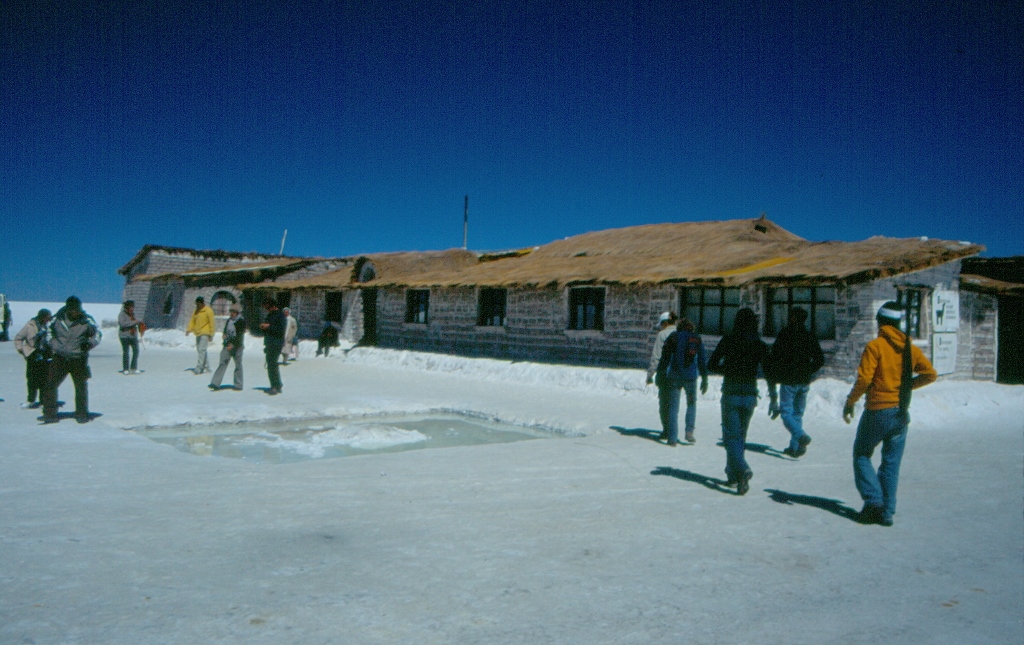 Salt hotel, Salar de Uyuni
Salt hotel, Salar de Uyuni